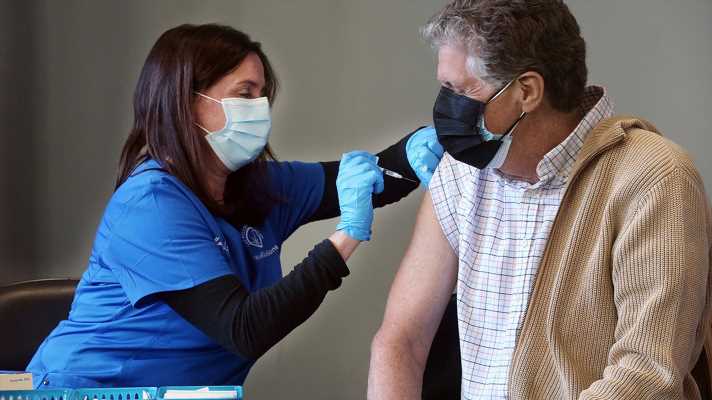It took just over a year for COVID-19 to kill half a million Americans.
By now, it should be a cautionary tale — health professionals laid out ways to save lives, public officials chose not to follow them, mass casualties ensued. An expert commission recently estimated that if the United States had responded as similarly wealthy countries did to the threat, we could have averted 40% — tens of thousands — of American COVID-19 deaths.
As we mourn and remember the people we’ve lost, let’s not forget that we are in a high-stakes race against new variants of SARS-CoV-2, the coronavirus that caused COVID-19. If we act swiftly, we have a chance to pull ahead and put the worst of this crisis behind us in the next few months. That means you could visit your family with less fear that you’ll transmit or contract the virus. You could breathe a little easier when you step out your door every day.
Here’s how we can win the race: Remove barriers to vaccinating the masses more quickly and starve the virus of every opportunity to spread and create new variants.
No time for COVID complacency
As viruses spread, they mutate and acquire variants. Much of this is accidental and is usually detrimental to the virus. However, occasionally, mutations enhance a virus’s ability to do things such as spread from person to person or withstand/evade neutralization by antibodies.
As of this writing, there have been over 115 million documented cases of COVID-19 globally, and scientists suspect there are tens of millions of undocumented cases. As such, the virus has had ample opportunity to mutate and give rise to variants.
COVID-19 vaccine on March 2, 2021, in Providence, Rhode Island. (Photo: Bob Breidenbach/AP)
There are several known variants so far, notably the B117 variant identified in the United Kingdom, and the B1351 variant identified in South Africa. The B117 variant can spread more easily than previous variants — in a span of 12 weeks, it went from accounting for less than 1% of detected COVID-19 cases, to more than 90% in the U.K. It’s now rapidly gaining ground in the United States, particularly in Florida.
So what do these variants mean for our current vaccines? Both the BioNTech/Pfizer and Moderna vaccines neutralize SARS-CoV-2 exceptionally well, with two-dose efficacy near 94% across age demographics. The new Janssen/Johnson and Johnson vaccine also shows promising results. Thankfully, scientists think the current vaccines effectively neutralize the newly identified variants — albeit at a slightly lower level for the B1351 variant.
Just say yes: COVID vaccines save lives. Get one even if your own life isn’t back to normal overnight.
All that being said, now is not the time for complacency. Even though COVID-19 cases and hospitalizations have declined in recent weeks, and vaccinations are increasing, some public officials and municipalities are reacting in the wrong way. Rather than taking advantage of the downward trends and driving the virus further into the ground, they’re lifting or easing restrictions at the slightest sign of improving metrics.
That includes Govs. Greg Abbott of Texas and Tate Reeves of Mississippi, who just announced they will lift their states’ mask mandates and allow all businesses to operate at full capacity. Several governors and mayors already have done away with mask mandates, reopened indoor dining, and approved other high-risk situations where SARS-CoV-2 can spread easily — giving the virus more opportunities to mutate.
Consider 3-week stay-at-home orders
Just because the vaccines can effectively neutralize currently transmitted SARS-CoV-2 variants doesn’t mean they will prevent future ones. Instead of lifting restrictions in response to signs of improvement, we should be doubling down on them. Governors and local officials should consider implementing a three-week stay-at-home order. They should consider closing all non-essential businesses and discouraging all non-essential travel to limit the potential for new variants. That will also allow resource-strapped public health departments and medical facilities to reallocate more staff and resources to vaccinating people instead of having to treat newly infected patients and allowing the more transmissible B117 variant to spread.
We can also use those three weeks to launch a rapid education campaign about COVID-19 vaccines. Supply shortages appear to be the biggest deterrent now to vaccinating more people, but all signs point to more vaccine availability soon.
COVID surprise: Many people love working from home. Can employers live with that?
Eventually, we’ll hit the wall of having already vaccinated all the people who want it immediately, and we’ll have to turn to those who are more hesitant. Recent polling shows that about half of American adults want the vaccine right away. That’s concerning, given that medical experts estimate we need to vaccinate between 75-80% of the population to develop “herd immunity” and effectively neutralize the pandemic. While COVID-19 vaccine hesitancy has decreased, we still clearly need to address legitimate concerns over the vaccines while simultaneously conveying how effective and safe they are.
We still have a way to go until this pandemic is truly “over.” But if we stop making the same mistakes, if we stop giving the virus opportunities to spread widely and mutate rapidly, we can move more quickly toward a safer future.
Matthew Wellington is Public Health Campaigns director at U.S. PIRG. Ryan McNamara, Ph.D., is a virologist and research associate scientist at the University of North Carolina at Chapel Hill School of Medicine. Follow them on Twitter: @matthewwell and @Ryan_Mac_Phd
You can read diverse opinions from our Board of Contributors and other writers on the Opinion front page, on Twitter @usatodayopinion and in our daily Opinion newsletter. To respond to a column, submit a comment to [email protected].
Source: Read Full Article

